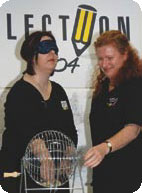Nominations
In this Section:
- Who could nominate as a candidate?
- Declaration of nominations
- Nominations overview
- Nominations system
- Draw for ballot paper positions
- Senate group voting tickets
Related House Results:
Related Senate Results:
A person could not be elected to the Senate or the House of Representatives at the 2004 federal election unless they had nominated as a candidate by the close of nominations at 12 noon on Thursday 16 September. The nomination date was extended by one day in the Division of Kalgoorlie due to the death of a candidate in that division. It was not possible to nominate as a candidate for the election until the writs had been issued and no one could nominate for more than one election held on election day.
Who could nominate as a candidate?
The eligibility qualifications for a candidate for the Senate and the House of Representatives are the same. To nominate as a candidate a person must be at least 18 years old, an Australian citizen, and an elector entitled to vote or a person qualified to become an elector. A person cannot nominate if, at the close of nominations, they do not meet all of the three eligibility requirements detailed above, are a current member of a State Parliament or Territory Legislative Assembly, or are disqualified by Section 44 of the Constitution.
Each candidate is required to pay a nomination deposit. At the 2004 election, a House of Representatives candidate was required to pay a $350 deposit, which was refundable if the candidate achieved four per cent or more of the formal first preference votes for the relevant division. A Senate candidate was required to pay a deposit of $700 which was refundable if the candidate (or if applicable, the Senate group in which the candidate was included) achieved four per cent or more of the formal first preference votes for the relevant State or Territory.
Declaration of nominations
Nominations for the 2004 federal election closed at 12 noon, Thursday 16 September 2004. Nominations were publicly declared 24 hours after the close of nominations at 12 noon, Friday 17 September (in the Division of Kalgoorlie, nominations were not declared until 12 noon, Saturday 18 September due to the death of a candidate). Nationally, 1 421 people nominated as candidates in the 2004 federal election. This figure included 330 candidates for the Senate and 1 091 candidates for the House of Representatives. There were 1 014 male candidates and 406 female candidates. (Note: details of gender were not provided for one candidate).
Nominations overview
Some particular points of interest from the 2004 federal election:
- 97 more candidates nominated than for the previous federal election in 2001
- 406 female candidates and 1 014 males nominated
- the number of male candidates increased by 71 from 2001 and the number of female candidates increased by 25 from 2001. In 2001 there were 943 male and 381 female candidates
- 51 registered political parties fielded candidates compared to 49 registered parties at 2001
- the largest number of candidates fielded in a division was 14 in the Division of Greenway (NSW)
- the smallest number of candidates fielded in a division was four. This occurred in the Divisions of Riverina (NSW), Throsby (NSW) and Braddon (TAS).
More information about nominations for the 2004 federal election can be found in the Electoral Newsfile No. 119.
Nominations system
Nominations were entered into the computerised nominations system at AEC divisional offices for House of Representatives candidates and at AEC State and Territory Head Offices for Senate candidates. The system produced a number of reports which were provided to the media, candidates, political parties and other interested people. This system also generated the artwork for the House of Representatives ballot papers. A national list of candidates was available soon after the last declarations of nominations were held in Western Australia. The list was distributed to members of the media, political parties, candidates and other interested people and placed on the AEC website.
Draw for ballot paper positions

A draw for ballot paper positions
The order in which candidates’ names appeared on the ballot paper was determined by two random draws. The draws were conducted immediately following the public declarations of nominations and were open to candidates, media and the public. Draws for Senate ballot paper positions were conducted by each AEO at their capital city head office. Draws for positions on the House of Representatives ballot papers were conducted by DROs at each of the 150 divisional offices. A double randomised system was used in the draw for both the House of Representatives and the Senate.
In the House of Representatives there were two draws. The first gave each candidate a number and the second draw determined the order in which each candidate appeared on the ballot paper. The same process occurred for the Senate, however, this draw is conducted in two separate parts, one part for groups and the other for ungrouped candidates. Each part consists of two draws. The first draw allocates a number to each group/ungrouped candidate and the second draw determines the order in which each group/ungrouped candidate will appear on the ballot paper.
Senate group voting tickets
Within 24 hours of the public declaration of nominations, Senate groups were able to lodge a voting ticket with the relevant State or Territory AEO. A voting ticket is a written statement setting out a preference ordering of all candidates in the election. When electors choose to vote for a group above the line on the Senate ballot paper, their preferences follow the ordering lodged by the Group.
Booklets setting out copies of all voting tickets lodged in that State or Territory were available at every polling place on election day. This information was also available on the AEC website.
